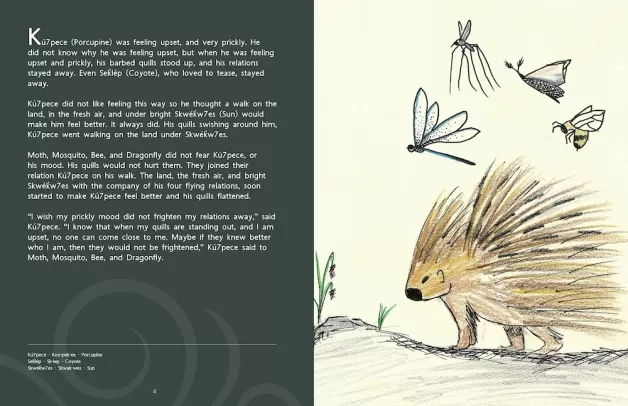Porcupine (PB)

Synopsis:
Preview Images (1)
Kú7pece (Porcupine) has always struggled with his emotions and pushed his relations away. Kú7pece does not like this part of himself and wants to explore his identity and learn more about himself, his family, and the land.
To connect with his relations and his friends, Kú7pece decides to build a gathering place: a c7ístkten̓ (winter home). This is a place he is hoping his relations can gather and learn about each other through sharing stories. However, Kú7pece traps the sun and soon gets distracted by the sun’s heat and light. So much so, he forgets who he is and his purpose. Soon he is trapped too and cannot see that he is neglecting his responsibilities.
It takes the sacrifice of his relations and friends to help him realize he was trapped in his own reality. Once he realizes the lesson of the sacrifice of his friends – that they were trying to help him reconnect to his own place and purpose – he uses all his courage to turn away from the sun’s heat and light. Slowly, he remembers his identity, purpose, and responsibilities. In the end, Kú7pece finds himself again and reconnects with his relations to gather to tell stories, learn from each other, and support one another.
Porcupine is a story about expressing emotions and being considerate to the needs of others. It works well as a bedtime story or read-aloud for classrooms.
This book works well with others by Mike Bowden and Kelsey Jules, including Four Winds, Bear and Coyote, and Chief Goose.
Educator Information
Recommended for grades 3 to 7.
This book is part of the Secwépemc Stories series.
This story is a great resource to introduce Indigenous languages to young readers. Secwepemctsín is one of 30 distinct Indigenous languages in British Columbia and is in the process of being revitalized after governments and religions developed policies to eliminate the rich language and culture of Indigenous peoples. The book integrates Secwépemc words into the text and includes a pronunciation guide on every page.
This story connects to the BC First Peoples’ Principles of Learning: learning is holistic, reflexive, experiential, and relational; learning involves the consequences of one’s actions; learning is embedded in story; and learning involves patience and time. Learning from Indigenous stories can be different and personal every time a story is read or told, depending on context. This book provides an opportunity for those reading to reflect, explore, connect, and learn on a personal interpretative level.
Curriculum links:
- Social emotional learning: identity, self-awareness, emotions, family, community, relationship skills
- Reading and language skills
- Indigenous knowledge and traditions
Additional Information
24 Pages | Colour illustrations | 22 x 28 cm | ISBN: 9781771745710 | Paperback

 Go
Back
Go
Back






